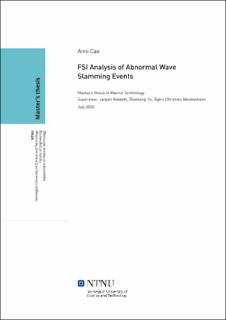| dc.description.abstract | Slamming impact is a hazardous phenomenon to ships and offshore structures, which is characterised by a highly nonlinear coupling interaction between the structure and the fluid. To evaluate it correctly and accurately is a fundamental task for marine engineers. There are several methods to simulate this phenomenon. One is the model test by experiments. But the disadvantage of the experiment is expensive and time-consuming, which makes the model test more challenging to handle in daily time. Other methods alternatively, like simplified calculation and numerical calculation in commercial codes also have their advantages and disadvantages. However, compared to the experiments, these methods could be convenient to access for the engineer.
As the development of commercial software these years, some representative software, e.g. LS-Dyna, ADyna could already give more accurate results than before. The solver could use less time to solve the problems with complex geometry. In this report, the slamming impact has been modelled as drop tests of a stiffened plate with a constant velocity. The drop tests were simulated in the finite element software LS-Dyna, where the fluid-structure interaction was modelled by ALE formulation. The primary purpose of this thesis is to explore the slamming phenomenon in numerical way, experience the procedure to proofread the structure and calculate the response under the slamming loads and find a more convenient method to approximate the impact response.
In this thesis, the steel column model is established first. For the FEM model in LS-Dyna, static analysis is conducted following. The boundary effects on the resistance curve of the steel column would be analysed. It is proved that the rear end boundary condition does not affect the resistance curve of the steel column. Different resistance curves are plotted in models with different plate thickness. SDOF parameters could be found from these plots. In ALE drop test, the detailed process of slamming events have been analysed. The displacement curve shows excellent consistency with the analytical model. From the section plots in the Appendix, the stiffeners deform first and the bulkhead following, the side plate girders give the plate and stiffeners robust support and almost unreformed during the whole impact process. Three groups of parametric study have been made to evaluate the effect of material properties, velocities, and plate thickness on the response of the structures. SDOF method has also been established by using the parameters from static analysis. Comparison between the SDOF method and ALE methods shows a feasible approximation by using the SDOF method to predict ALE results. Finally, dynamic tests are made trying to find the possibility to use the elastic material result to predict the response of elasto-plastic material. Even though the effect is not impressive, it provides a new way of thinking. | |
